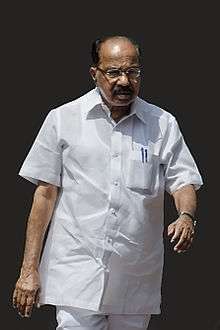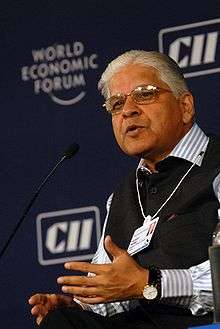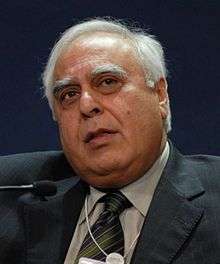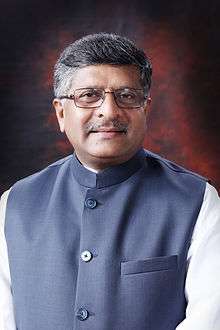Ministry of Law and Justice (India)
| विधि एवं न्याय मंत्रालय | |
|
| |
| Agency overview | |
|---|---|
| Formed | 1833[1] |
| Jurisdiction | Government of India |
| Headquarters |
Cabinet Secretariat Raisina Hill, New Delhi 28°36′50″N 17°12′32″E / 28.61389°N 17.20889°E |
| Agency executive |
|
| Child agencies |
|
| Website |
lawmin |
The Ministry of Law and Justice is the highest Section of the Government of India which deals with the management of the legal affairs, legislative activities and administration of justice in India through its three departments namely the legislative department and the department of legal affairs and department of justice respectively. The Department of Legal Affairs is concerned with advising the various Ministries of the Central Government while the Legislative Department is concerned with drafting of principal legislation for the Central Government. The ministry is headed by a cabinet rank minister appointed by the President of India on the recommendation of the Prime Minister of India.[1][2] Ravi Shankar Prasad is the current minister for law and justice in India.
History
Ministry of law and justice is the oldest limb of the government of India dating back to 1833 when the Charter Act 1833 was enacted by the British Parliament when India was under British control. The said Act vested for the first time legislative power in a single authority, namely the Governor General in Council. By virtue of this authority and the authority vested under him under section 22 of the Indian Councils Act 1861 the Governor General in Council enacted laws for the country from 1834 to 1920. After the commencement of the Government of India Act 1919 the legislative power was exercised by the Indian Legislature constituted thereunder. The Government of India Act 1919 was followed by the Government of India Act 1935. With the passing of the Indian Independence Act 1947 India became a 'dominion' and the 'dominion legislature' made laws from 1947 to 1949 under the provisions of section 100 of the Government of India Act 1935 as adapted by the India (Provisional Constitution) Order 1947. When the Constitution of India came into force on 26 January 1950, the legislative power thereafter got vested in the Indian parliament.[1]
Structure
The Government of India (Allocation of Business) Rules of 1961 entail the various departments working under the Ministry of Law and Justice of Government of India. In terms of these Rules, the Ministry comprises the following departments:
- Department of Legal Affairs,
- Legislative Department, and
- Department of Justice.[3]
Legislative Department
The Legislative Department is mainly concerned with drafting of all principal legislation for the Central Government i.e. Bills to be introduced in Parliament, Ordinances to be promulgated by the President, measures to be enacted as President's Acts for States under the President's rule and Regulations to be made by the President for Union territories. It is also concerned with election Laws namely the Representation of the People Act 1950 and the Representation of the People Act 1951. In addition it is also entrusted with task of dealing with certain matters relating to List III of the Seventh Schedule to the Constitution like personal law, contracts evidence etc. The responsibility of maintaining up to date the statutes enacted by Parliament is also with this Department. The Allocation of Business Rules identify the following functions to be carried out by this Department;
- The drafting of Bills, including the business of the Draftsmen in Select Committees, drafting and promulgation of Ordinances and Regulations; enactment of State Acts as President's Acts whenever required; scrutiny of Statutory Rules and Orders (except notifications under clause (a) of section 3, section 3A and section 3D, of the National Highways Act, 1956 (48 of 1956)).
- Constitution Orders; notifications for bringing into force Constitution (Amendment) Acts.
- (a) Publication of Central Acts, Ordinance and Regulations; (b) Publication of authorised translations in Hindi of Central Acts, Ordinances, Orders, Rules, Regulations and bye-laws referred to in section 5(1) of the Official Languages Act, 1963 (19 of 1963).
- Compilation and publication of unrepealed Central Acts, Ordinances and Regulations of general statutory Rules and Orders, and other similar publications.
- Elections to Parliament, to the Legislatures of States, to the Offices of the President and Vice-President; and the Election Commission.
- Preparation and publication of standard legal terminology for use, as far as possible, in all official languages.
- Preparation of authoritative texts in Hindi of all Central Acts and of Ordinances promulgated and Regulations made by the President and of all rules, regulations and orders made by the Central Government under such Acts, Ordinances and Regulations.
- Making arrangements for the translation into official languages of the States of Central Acts and of Ordinances promulgated and Regulations made by the President and for the translation of all State Acts and Ordinances into Hindi if the texts of such Acts or Ordinance are in a language other than Hindi.
- Publication of law books and law journals in Hindi.
- Marriage and divorce; infants and minors; adoption, wills; intestate and succession; joint family and partition.
- Transfer of property other than agricultural land (excluding benami transactions registration of deeds and documents).
- Contracts, but not including those relating to agricultural land.
- Actionable wrongs.
- Bankruptcy and insolvency.
- Trusts and trustees, Administrators, General and Official Trustees.
- Evidence and oaths.
- Civil Procedure including Limitation and Arbitration.
- Charitable and religious endowments and religious institutions.
Department of Justice
The Department of Justice performs the administrative functions in relation to the appointment of various judges at various courts in India, maintenance and revision of the conditions and rules of service of the judges and other related areas. The Allocation of Business Rules identify the following functions to be carried out by this Department;
- Appointment, resignation and removal of the Chief Justice of India and Judges of the Supreme Court of India; their salaries, rights in respect of leave of absence (including leave allowances), pensions and travelling allowances.
- Appointment, resignation and removal, etc., of Chief Justice and Judges of High Courts in States; their salaries, rights in respect of leave of absence (including leave allowances), pensions and travelling allowances.
- Appointment of Judicial Commissioners and Judicial officers in Union Territories.
- Constitution and organisation (excluding jurisdiction and powers) of the Supreme Court (but including contempt of such Court) and the fees taken therein.
- Constitution and organisation of the High Courts and the Courts of Judicial Commissioners except provisions as to officers and servants of these courts.
- Administration of justice and constitution and organisation of courts in the Union Territories and fees taken in such courts.
- Court fees and Stamp duties in the Union Territories.
- Creation of all India Judicial Service.
- Conditions of service of District Judges and other Members of Higher Judicial Service of Union Territories.
- Extension of the Jurisdiction of a High Court to a Union Territory or exclusion of a Union Territory from the Jurisdiction of a High Court.
Ministers
See also
References
- 1 2 3 "Ministry of Law and Justice - About Us". Ministry of Law and Justice. Retrieved 29 May 2014.
- ↑ "About Ministry of Law and Justice (More information)". Minsitry of Law and Justice. Retrieved 29 May 2014.
- ↑ "Government of India (Allocation of Business) Rules of 1961". Parliament of India. Retrieved 29 May 2014.
- ↑ RAJYA SABHA MEMBERS, BIOGRAPHICAL SKETCHES, 1952 - 2003: A
- ↑ RAJYA SABHA MEMBERS, BIOGRAPHICAL SKETCHES, 1952 - 2003: B
- 1 2 3 RAJYA SABHA MEMBERS, BIOGRAPHICAL SKETCHES, 1952 - 2003:
- 1 2 Biographical Sketch, Member of Parliament, 12th Lok Sabha : SHIV SHANKER, SHRI P.
- ↑ 8th Lok Sabha, Members Bioprofile : KAUSHAL, SHRI JAGANNATH
- ↑ Tenth Lok sabha;, Members Bioprofile; SHANKARANAND, SHRI B.; Lok Sabha/National Informatics Centre
- ↑ RAJYA SABHA MEMBERS, BIOGRAPHICAL SKETCHES, 1952 - 2003: G
- ↑ Biographical Sketch, Member of Parliament, 12th Lok Sabha: SWAMY, DR. SUBRAMANIAN
- ↑ Biographical Sketch, Member of Parliament, 12th Lok Sabha: REDDY, SHRI KOTLA VIJAYA BHASKARA
- ↑ Biographical Sketch, Member of Parliament, XI LOK SABHA : KHALAP, SHRI RAMAKANT D.
- ↑ Minister of State (Independent Charge)
- ↑ Sixteenth Lok Sabha, Members Bioprofile : Thambidurai,Dr. Munisamy
- ↑ Jaitley was Minister of State (Independent Charge) for Law and Justice till 7 November 2000, then was Union Cabinet Minister
- ↑ RAJYA SABHA MEMBERS, BIOGRAPHICAL SKETCHES, 1952 - 2003: K
- ↑ Sixteenth Lok Sabha, Members Bioprofile: Moily, Dr. M. Veerappa
- ↑ Fifteenth Lok Sabha, Members Bioprofile: Khurshid, Shri Salman
- ↑ Fifteenth Lok Sabha, Members Bioprofile: Sibal, Shri Kapil
new act The Central Board of Direct Taxes (CBDT) is a part of the Department of Revenue in the Ministry of Finance, Government of India.[24] The CBDT provides essential inputs for policy and planning of direct taxes in India and is also responsible for administration of the direct tax laws through Income Tax Department. The CBDT is a statutory authority functioning under the Central Board of Revenue Act, 1963.It is India’s official FATF unit.The Central Board of Revenue as the Department apex body charged with the administration of taxes came into existence as a result of the Central Board of Revenue Act, 1924. Initially the Board was in charge of both direct and indirect taxes. However, when the administration of taxes became too unwieldy for one Board to handle, the Board was split up into two, namely the Central Board of Direct Taxes and Central Board of Excise and Customs with effect from 1.1.1964. This bifurcation was brought about by constitution of the two Boards u/s 3 of the Central Boards of Revenue Act, 1963.
External links
- Ministry of Law and Justice Official website of the Ministry of Law and Justice
- Department of Law and Justice
- Department of Legal Affairs
- Law Commission of India

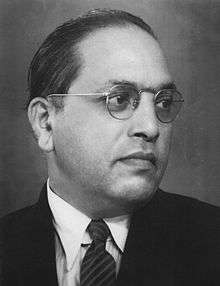
.jpg)

